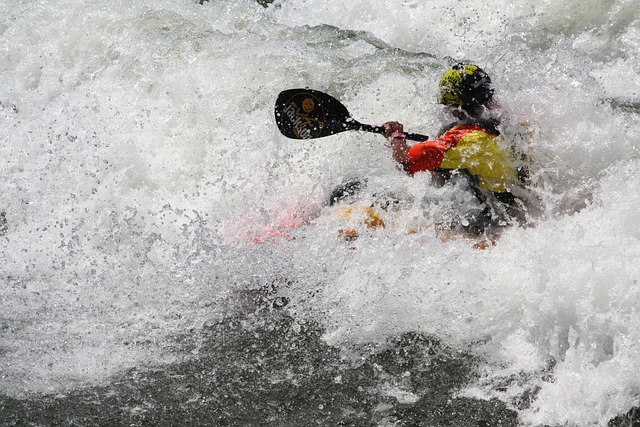Kayaking is an enjoyable outdoor activity, but safety should always be your top priority. To stay safe on the water, it’s essential to be aware of weather conditions and common hazards. This comprehensive guide will provide you with the knowledge and expert tips you need to have a secure and enjoyable kayaking experience. From understanding weather patterns to navigating strong currents and waves, this guide has everything you need to know to stay safe on your next kayaking adventure.
In this guide, I will discuss the safety aspects of kayaking, specifically focusing on weather conditions and hazards that you may encounter while kayaking. I’ll also explain the 120-degree rule, a key principle to keep in mind when planning your kayaking trip. By the end of this article, you’ll have a better understanding of how to stay safe while enjoying your kayaking adventures. Let’s get to it!
Weather Conditions and Kayaking Safety
Kayaking in bad weather or stormy conditions can be extremely dangerous, so it’s important to know what to look for and when to avoid kayaking altogether. Here are some key things to consider when it comes to weather conditions and kayaking safety:
- What weather conditions are best for kayaking?
- Generally, calm, clear weather conditions are best for kayaking.
- Avoid kayaking during extreme weather conditions, such as thunderstorms, high winds, or heavy rain.
- What winds are too high for kayaking?
- The answer to this question can depend on several factors, including your skill level and the size of your kayak.
- In general, winds over 15 knots (about 17 miles per hour) can make kayaking difficult and unsafe.
- Can lightning strike you in a kayak?
- Yes, lightning can strike kayakers on the water.
- If you hear thunder or see lightning, get off the water immediately and seek shelter.
- What to do if it storms while kayaking?
- If you’re caught in a storm while kayaking, get to shore as quickly and safely as possible.
- If you can’t get to shore, try to stay low in your kayak and avoid holding onto metal objects.
Remember, the weather can change quickly, so it’s important to monitor the forecast and be prepared to change your plans if necessary. Always err on the side of caution when it comes to kayaking in bad weather conditions.
Hazards While Kayaking
Kayaking can be a fun and exciting experience, but it’s important to be aware of the potential hazards that can arise. Here are some of the most common hazards you may encounter while kayaking and how to avoid them:
- Strong currents:
- Avoid kayaking in areas with strong currents, such as near dams or in areas with rapidly changing tides.
- If you find yourself in strong currents, paddle perpendicular to the current to get out of it.
- Waves:
- Waves can be fun to paddle through, but they can also capsize your kayak if they’re too large.
- Avoid kayaking in areas with waves that are too high for your skill level.
- Rocks and other obstacles:
- Always be aware of obstacles in the water, such as rocks, logs, and branches.
- If you encounter an obstacle, try to steer your kayak around it, but avoid sudden movements that could cause you to capsize.
- Hypothermia:
- Hypothermia can occur when you’re exposed to cold water for an extended period of time.
- Dress appropriately for the weather and wear a wetsuit or dry suit in colder conditions.
- Wildlife:
- Be aware of the wildlife in the area where you’re kayaking, such as snakes or alligators.
- Give animals their space and avoid approaching them too closely.
Remember to always wear a personal flotation device (PFD) and other necessary safety equipment, and to let someone know where you’re going and when you’ll be back. By being aware of potential hazards and taking the necessary precautions, you can minimize the risks and enjoy a safe kayaking experience.
The 120-Degree Rule for Kayaking
The 120-degree rule is a key principle to keep in mind when planning your kayaking trip. The rule states that you should never be more than 120 degrees away from shore. Here’s why:
- Safety:
- Staying within 120 degrees of shore ensures that you’re never too far away to reach safety if an emergency arises.
- Navigation:
- It’s easier to navigate and stay on course if you’re always within sight of the shoreline.
- Energy conservation:
- Staying within 120 degrees of shore allows you to conserve energy and avoid paddling against strong currents or winds.
To apply the 120-degree rule, simply visualize a 120-degree angle between your starting point and the two points that mark the limit of your paddling range. When planning your route, ensure that you stay within this angle at all times. If you need to paddle further out, make sure you have the necessary skills, experience, and safety equipment to do so.
Remember, the 120-degree rule is just one of many safety principles to keep in mind when kayaking. Always be aware of your surroundings, monitor weather and water conditions, and use good judgment when planning your trip. By following these guidelines, you can have a safe and enjoyable kayaking experience.
Conclusion
In conclusion, kayaking can be a fun and exhilarating experience, but it’s important to prioritize safety at all times. By being aware of weather conditions, and potential hazards, and following expert tips, you can minimize risks and enjoy a secure kayaking trip.
Remember to always be aware of your surroundings, monitor weather and water conditions, and use good judgment when planning your trip. Don’t forget to wear appropriate safety gear, let someone know your plans, and stay within your skill level. By following these guidelines, you can minimize the risks and enjoy a safe and memorable kayaking experience.










